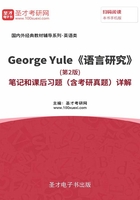
第5章 语 音
5.1 复习笔记
本章要点:
1.The definition of classification of phonetics
语音学的定义和分类
2.Distinction, Classification and the Criteria of Description between Constants and Vowels
辅音和元音的区别、分类及描写规则
3.Manner of articulation and place of articulation
发音方式和发音部位
本章考点:
语音学的定义;发音语音学;听觉语音学;声学语音学;发音部位、发音方式和分类;英语元音的定义和分类、基本元音;和辅音的区别等。
本章内容索引:
I. Phonetics
1.The definition of phonetics
2.Four major research areas of phonetics
(1) Articulatory phonetics
(2) Acoustic phonetics
(3) Auditory phonetics
(4) Forensic phonetics
II. Articulation: voiced and voiceless
1.Speech organs
2.Voiced sounds
3.Voiceless sounds
III. Consonants
1.The definition of consonants
2.Place of articulation
3.Charting consonant sounds
4.Manner of articulation
IV. Vowels
1.The definition of vowels
2.Monophthongs and Diphthongs
3.The distinction between vowels and consonants
4.Notes on the vowel chart
I. Phonetics(语音学)
【考点】语音学的定义和研究领域
1.The definition of phonetics(语音学的定义)
The general study of the characteristics of speech sounds is called phonetics. It studies how speech sounds are produced, transmitted, and perceived.
语音学研究语音的特点。语音学研究语音如何发出、传递和接收。
2.Four research areas of phonetics(语音学四大研究领域)
①Articulatory phonetics is the study of how speech sounds are made, or “articulated”. It has been the primary interest.
②Acoustic phonetics deals with the physical properties of speech as sound waves ‘in the air’.
③Auditory phonetics deals with the perception, via the ear, of speech sounds.
④Forensic phonetics has applications in legal cases involving speaker identification and the analysis of recorded utterances.
①发音语言学研究语音的发生,是语音学研究的主要兴趣所在。
②声学语音学研究语音作为声波的物质特征。
③感知语音学(或听觉语音学)研究语音的感知。
④司法语音学用于法律案件中研究语音识别和分析录音材料。
II. Articulation: voiceless and voiced(发音:清音和浊音)
【考点】清音和浊音的定义
1.Speech organs(发音器官)
①Speech organs(vocal organs) are those part of the human body involved in the production of speech.
The lungs, the trachea, the throat, the nose and the mouth
The mouth: the tongue, the plate
The throat: pharynx (upper), larynx (lower)
The vocal tract: the pharynx, mouth, and nose
The mouth: the oral cavity
The nose: the nasal cavity
②The vocal cords are either apart, close together, or totally closed.
①发音器官指人体参与发音的部分。
肺、气管、喉咙、鼻子和嘴
嘴:舌头、腭
喉咙:咽、喉
声道:咽、嘴和鼻子
嘴:口腔
鼻子:鼻腔
②声带可以张开、闭合或完全关闭。
2.Voiceless sounds(清音)
When the vocal cords are spread apart, the air from the lungs passes between them unimpeded. Sounds produced in this way are described as voiceless.
发音过程中声带舒展,气流从胸腔顺利通过口腔,毫无阻力,此时发出的声音为清音。
3.Voiced sounds(浊音)
When the vocal cords are drawn together, the air from the lungs repeatedly pushes them apart as it passes through, creating a vibration effect. Sounds produced in this way are described as voiced.
发音过程中声带收紧,气流冲破阻力产生震动,发出的音为浊音。
III.. Consonants(辅音)
1.The definition of consonants(辅音的定义)
【考点】辅音的定义&根据描述指出辅音名称
Consonants are sounds produced by constricting or obstructing the vocal tract at some places to divert, impede or completely shut off the flow of air in the oral cavity.
发音时,声道的某些部位受到压缩或阻碍后,使得气流在口腔里转向、受阻或被完全阻塞,由此产生的音叫做辅音。
2.Place of articulation(发音部位)
In terms of place of articulation, the consonants can be grouped into:
Bilabials: [p, b, m, w]
Labiodentals: [f, v]
Dentals:[θ, ð]
Alveolars: [t, d, n, s, z, r, l ]
Palatals: [ʃ, tʃ, ʒ, ʤ, j]
Velars: [k, g, ŋ]
Glottal: [h]
按发音部位分类,辅音可分为:
双唇音:[p, b, m, w]
唇齿音:[f, v]
齿音:[θ, ð]
齿龈音:[t, d, n, s, z, r, l ]
硬腭音:[ʃ, tʃ, ʒ, ʤ, j]
软腭音:[k, g, ŋ]
声门音:[h]
3.Charting consonant sounds(辅音音图)
(1) The basic information of the chart(音图的基本信息)
Along the top of the chart are the different labels for places of articulation and, under each, the labels -V (= voiceless) and +V (= voiced).
图表的顶部标记着不同的发音位置,每个位置下方都标记着-V(表示浊音),或+V(表示清音)。
(2) Limitations of the chart(音图的局限性)
①This chart is less comprehensive than the one produced by the International Phonetic Association (IPA).
②Another one is the single entry covering r sounds in English.
③In some phonetic descriptions, there are different symbols for few of the sounds represented here, compared with that of IPA.
①该音图相比IPA不全面。
②“r”音在该表中只表示了一种形式,并不全面。
③该表中一些语音符号与IPA中有些不同。
4.Manner of articulation(发音方式)
In terms of manners of articulation, consonants can be grouped into:
Stops(plosive): [p, b, t ,d, k, g]
Fricatives:[f, v, θ, ð, s, z, ʃ, ʒ, h]
Affricates: [dʒ, tʃ]
Nasals:[m, n, ŋ]
Approximants:[w, j, l, r, h]
Glottal stop:[ʔ]
Flap: [D] or [ɾ]
按发音方式分类,辅音可分为:
爆破音: [p, b, t, ,d, k, g]
擦音: [f, v, θ, ð, s, z, ʃ, ʒ, h]
塞擦音: [dʒ, tʃ]
鼻音:[m, n, ŋ]
通音: [w, j, l, r, h]
声门塞音:[ʔ]
闪音:[D],有时也用[ɾ]表示。
IV. Vowels(元音)
【考点】描述给定元音&根据描述指出元音名称
1.The definition of vowels(元音的定义)
Vowels are sounds produced without obstruction, so no turbulence or a total stopping of the air can be perceived.
发音时,声道不受任何压缩或阻碍,因此不会有气流的紊乱或停滞,由此产生的音叫做元音。
(1) The Height of the Tongue(舌头最高部分的高度)
Front vowels: [i:] [ɪ] [ɛ] [æ]
Central vowels: [ə] [ʌ]
Back vowels: [u] [ʊ] [o] [ɔ] [ɑ]
前元音:[i:] [ɪ] [ɛ] [æ]
中元音:[ə] [ʌ]
后元音:[u] [ʊ] [o] [ɔ] [ɑ]
(2) The Shape of the Lips(唇的圆展度)
Rounded vowels: [u:] [u] [ɔ:] [ɔ]
Unrounded vowels: [i:] [ɪ] [e] [ɛ] [æ] [ɑ] [ɜ:] [ə] [ʌ] [ɑ:]
圆唇音:[u:] [u] [ɔ:] [ɔ]
展唇音:[i:] [ɪ] [e] [ɛ] [æ] [ɑ] [ɜ:] [ə] [ʌ] [ɑ:]
(3) The Width of the Mouth(开口的宽度)
Open vowels: [æ], [ɑ], [ɔ], [ɑ:]
Close vowels: [i:], [ɪ],[u:], [u]
Semi-open vowels: [ɔ:] [e] [ɛ] [ɜ:] [ə] [ʌ]
开元音:[æ], [ɑ], [ɔ], [ɑ:]
闭元音:[i:], [ɪ],[u:], [u]
半开元音:[ɔ:] [e] [ɛ] [ɜ:] [ə] [ʌ]
2.Monophthongs and Diphthongs(单元音与双元音)
Monophthong: They are those pure vowels that have an unchanging quality, either from the number or the constant quality.
Diphthong: A sequence of two sounds produced from one vowel position to another.
单元音:指在数量上和性质上都恒定不变的纯元音。
双元音:发音时由第一个单元音滑向第二个单元音,所产生的音的组合就叫做双元音。
3.The distinction between vowels and consonants(元音和辅音的区别)
①The distinction between vowels and consonants lies in the obstruction of airstream.
②As there is no obstruction of air in the production of vowels, the description of the consonants and vowels cannot be done along the same lines.
①元音和辅音的区别在于气流是否受阻。
②元音发音时气流不受阻,所以在对元音和辅音进行描述时不能采用相同的方式。
4.Notes on the vowel chart(对于元音音图的说明)
①Vowel sounds are notorious for varying between one variety of English and the next, often being a key element in what we recognize as different accents.
②There are many other variations in the actual physical articulation of the sounds we have considered here.
①元音在不同的英语变体中发音不同,这常常是导致出现不同方言的一个主要因素。
②在实际的发音过程中,有很多的变体。